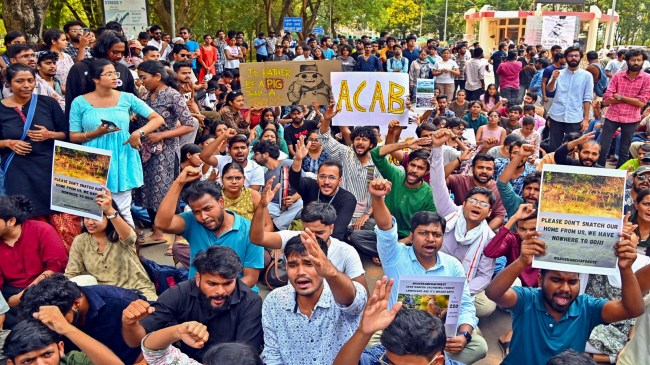Opinion From Hyderabad University land row, a question: Is short-term profit more important than long-term excellence?
On the one hand, the university has been climbing in the rankings and on the other, its space is shrinking
 Students of the University of Hyderabad raise slogans during their protest demanding the removal of police personnel and earth-moving machinery from the campus, in Hyderabad. (Source: PTI)
Students of the University of Hyderabad raise slogans during their protest demanding the removal of police personnel and earth-moving machinery from the campus, in Hyderabad. (Source: PTI) Hyderabad Central University, also known as the University of Hyderabad, came into existence in 1974 by an Act of Parliament. It is the only institution of higher education that is mentioned in Article 371E of the Constitution. The then Prime Minister Indira Gandhi instructed the government of Andhra Pradesh to allot land for the university and more than 2,300 acres were given. Almost immediately, the first vice-chancellor built a boundary wall by spending more than Rs 2 crore. The university soon excelled in research, teaching, and experiments that provided quality education. However, the legal rights over land are neither transferred nor registered to the university. As the university was located on the outskirts of Hyderabad city, few anticipated that the cost of land would skyrocket as it has.
From the 1990s, the growing corporate capital and rapid urbanisation led to an increase in the price of land. Now, several moneyed interests are eyeing the land. Initially, some acres were allotted for public utilities roads, a sports stadium etc. This gave way gradually to public-private partnerships and now, the auctioning of 400 acres of land in Kancha Gachibowli within the boundary wall of the University is the source of a confrontation between the Telangana government and university administration. There is conflicting information around the land survey and topography demarcation. Cases have been filed and the police deployed against protesting students.
The confrontation between stakeholders from the university and state government is based on the fact that of the total of 2,300 acres, more than 800 acres were given away and of the 1,500 acres left, 400 acres are being auctioned off. This leaves just 1100 acres for the university to grow. On the one hand, the university has been climbing in the rankings and on the other, its space is shrinking.
HCU has made a mark globally due to the consistent efforts of academics to publish hundreds of articles every year in top-rated global journals in the world, presenting papers in international conferences and policy consultations at the state, national and international levels. Recognising its potential, both national and international organisations including private bodies have been extending financial assistance for academic activities. While utilising this support, the university needs to further excel in the academic world. This requires basic infrastructure in the form of well-equipped classrooms, laboratories, and field areas for experiments. The shrinking size of the university affects all of this.
From the biodiversity point of view, there are about 233 varieties of birds and animals, including fish-eating eagles, peacocks, painted stork, spot-billed pelicans, Indian rock pythons, Bengal monitor lizards, deer, etc. There are about 40,000 plants and trees, water bodies, and rock formations, which all together reduce the temperature by 1-4 degrees compared to Hyderabad city.
The greenness on the campus looks like an oasis in a concrete jungle – the surrounding areas are full of IT companies, multi-floor buildings, corporate hospitals, educational institutions, and commercial complexes. The rulers of the state want to auction off 400 acres of this oasis, rather than invest in making it an even greater centre of excellence.
The writer is professor, Department of Political Science, University of Hyderabad






